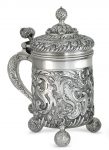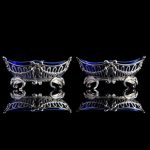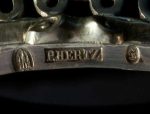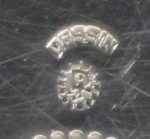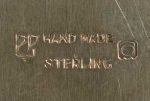Peter Hertz opened his workshop in 1834 and for a period of time had a location in Ostergrade but eventually settled on the corner of Kobmagergrade and Kronpirnsengrade in Copenhagen where it exists today. He won exhibitions in Malmo in 1881, Liverpool 1886, Paris 1889, and Chicago 1895, with his jewelry and hollow-ware pieces that showcased scenes from Danish history. In 1906, one of his most notable pieces, a centerpiece with two twelve armed candelabra featuring a scene from the Nordic Edda, of Gefion plowing out Zealand was created. That very year he was also appointed as Court Jeweler. In 1876, his sons, Jacob and Sally continued the silver tradition and opened the first silver factory to use electricity in Denmark, which continued under Johan and Knud Hertz until it was shut down in 1960. Although the select few pieces made under the P. Hertz name are now executed y Erik Sjodahl, the shop itself still remains. Many of the pieces created by P. Hertz at the turn of the century were designed by such notable names as Johan Rhode, Thorvald Bindesboll, and Harald Slott-Moller. Reference: Jensen Silver
A DANISH SILVER TANKARD MARK OF P. HERTZ, COPENHAGEN, 1901 Cylindrical on three ball feet, body, cover, handle and feet heavily chased with scrolling foliage and flowers, gilt interior, double domed hinged cover with bud finial, scrolling handle with bud thumbpiece, marked on base and cover 13 in. (33 cm.) high; 48 oz. (1495 gr.)
Sold for USD 6,875 at Christies in 2008
Pair of 19th C Danish silver salts
Oblong form salt cellar bowl raised on ram form feet, with pierced decoration and swag garlands topped with bows around the body. Empty cartouches and cobalt blue liners. 1893. P. Hertz. 75g.weighable. L. 9.2 cm (3 5/8 in.)
Sold for CA$275 at A.H. Wilkens Auctions & Appraisals in 2019
Peter Hertz Danish Silver Makers Mark
Johan Rohde was co-founder in 1891 of the secessionist group, Den Frie Udstilling (the Free Exhibition). Through this group he first met Georg Jensen, who in 1897 exhibited at Den Frie Udstilling the sculpture that had been rejected by the Danish Academy. Both later spent periods in the workshop of the silversmith Mogens Ballin, from which Jensen set up his own workshop in 1906. Rohde’s first silver designs, made in 1905 for his own house, were executed by Georg Jensen. He began to collaborate with Jensen in 1908, but it was not until 1917 that he entered into a formal association, which lasted until his death in 1935. During this time Rohde also designed silver for other Copenhagen firms. Reference: British Museum.
A set of eight Danish silver shot glasses #741, designed by Johan Rohde, Georg Jensen Silversmithy, Copenhagen, 1945-77 with openwork scroll stems marked on bases height 2 3/8 in. 6 cm 11 oz 342 g
Sold for 1,375 USD at Sothebys in 2018
